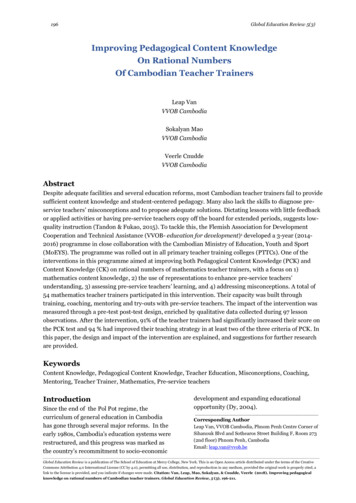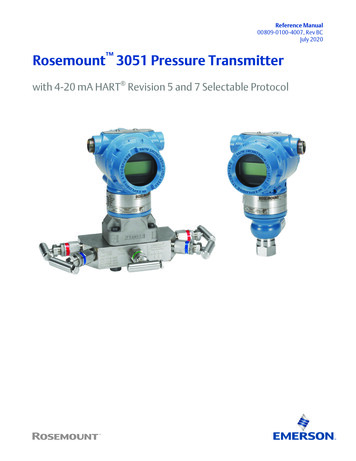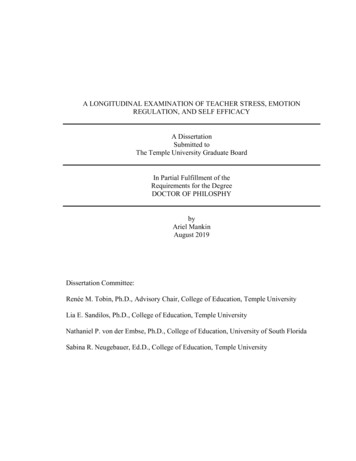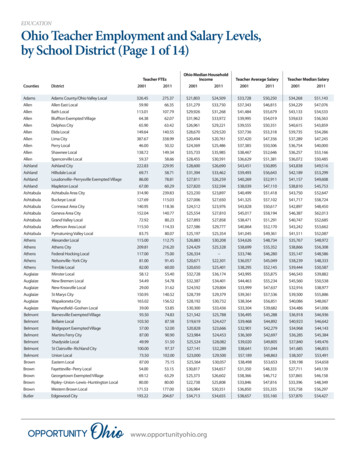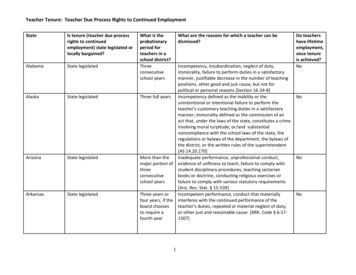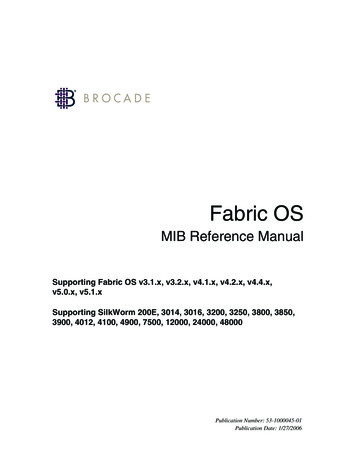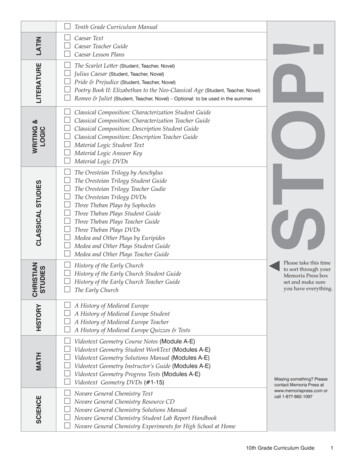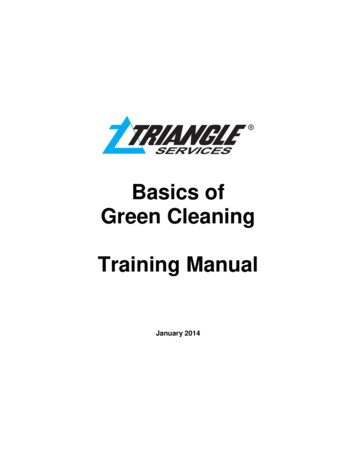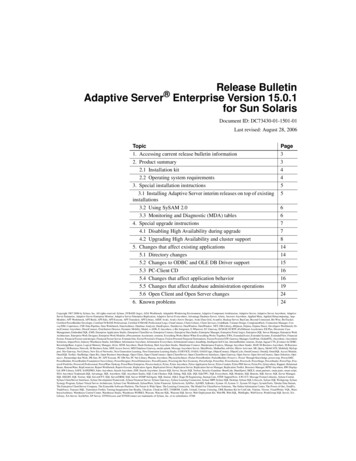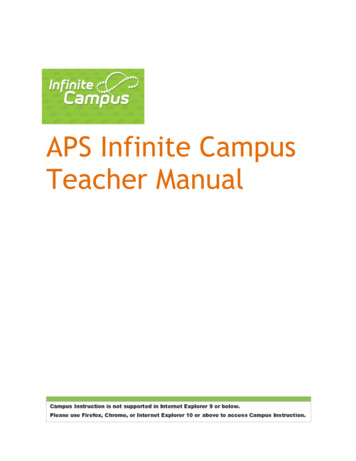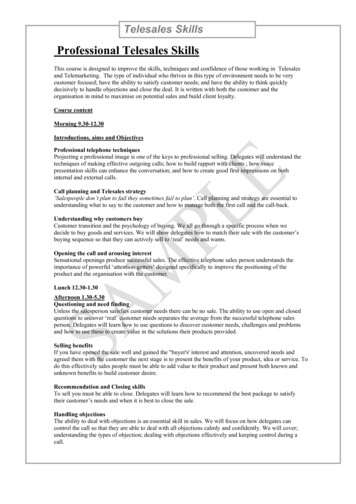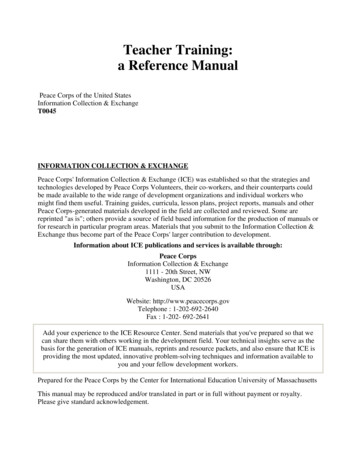
Transcription
Teacher Training:a Reference ManualPeace Corps of the United StatesInformation Collection & ExchangeT0045INFORMATION COLLECTION & EXCHANGEPeace Corps' Information Collection & Exchange (ICE) was established so that the strategies andtechnologies developed by Peace Corps Volunteers, their co-workers, and their counterparts couldbe made available to the wide range of development organizations and individual workers whomight find them useful. Training guides, curricula, lesson plans, project reports, manuals and otherPeace Corps-generated materials developed in the field are collected and reviewed. Some arereprinted "as is"; others provide a source of field based information for the production of manuals orfor research in particular program areas. Materials that you submit to the Information Collection &Exchange thus become part of the Peace Corps' larger contribution to development.Information about ICE publications and services is available through:Peace CorpsInformation Collection & Exchange1111 - 20th Street, NWWashington, DC 20526USAWebsite: http://www.peacecorps.govTelephone : 1-202-692-2640Fax : 1-202- 692-2641Add your experience to the ICE Resource Center. Send materials that you've prepared so that wecan share them with others working in the development field. Your technical insights serve as thebasis for the generation of ICE manuals, reprints and resource packets, and also ensure that ICE isproviding the most updated, innovative problem-solving techniques and information available toyou and your fellow development workers.Prepared for the Peace Corps by the Center for International Education University of MassachusettsThis manual may be reproduced and/or translated in part or in full without payment or royalty.Please give standard acknowledgement.
ContentsAcknowledgementsIntroductionPeace corps and teacher trainingFormat of the teacher training reference manualUses of the manualChapter 1 what a teacher trainer needs to knowUnderstanding comparative educational systemsThe education systemThe teacher training systemNeeds assessmentAdult learningAndragogy vs. pedagogyPersonal learning stylesMotivationConsiderations in designing a training programDefining program goals and objectivesSelecting topic areasDesigning learning activitiesTraining rhythm and flowIncorporating program evaluationAnalyzing training constraintsTraining techniques1. Ice breaker:2. Brainstorming:3. Lecturettes:4. Demonstrations:5. Games/Simulations/Structured experiences:6. Small groups (diads, triads, and more):7. Role play:8. Fishbowl:9. Field trips:10. Interviews:11. Panels:12. Case studies:13. Critical incidents:14. Micro-teaching:15. Peer training:Supervision
Clinical supervisionObservationObservation techniquesData collectionFinal considerations for the trainerAssessing personal training constraintsReassessing teacher needsChapter 2 what a teacher needs to knowUnderstanding the educational processNeeds assessment, aims, goals and general objectivesApproaches to teachingSources of teaching approachesSummary chart of approachesChoosing an approachRecent research in teacher effectivenessAdapting teaching approaches to the cultural settingChild and adolescent learningDevelopmental theoriesThe cognitive domainThe affective domainThe psychomotor domainInformation processingBasic sensory perceptionLearning stylesGrouping strategiesConsiderations in cross-cultural settingsSubject-specific considerationsInstructional objectivesWriting a complete objectiveCategories of instructional objectivesVerbs to use in writing objectivesAvoiding errors in stating objectivesSubject-specific verbsLesson planningWhat teachers say about planningWhat's in a planPlanning daily lessonsWriting a lesson planLesson plan formatSequencing and long-range planningChoosing from alternativesClassroom teaching techniques
Teacher-centered and student-centered techniquesTeacher-centered techniquesThe lecture methodQuestion and answerRecitation and drillStudent-centered techniquesSmall group formationBrainstormRole playGames and simulationsDrama and musicField tripsIndividualized learning and student projectsMaterials development and resource utilizationInstructional materials and the learning processUsing what is availableProducing educational materialsUsing materials in the classroomEvaluating instructional materialsClassroom managementThe physical aspects of the classroomCurriculum design considerationsExpectations and limitsSupport systemsTeacher attitudeTeaching routinesTeacher on stageAddressing individual needsHandling discipline problemsUsing the least amount of necessary disciplineAssessment of student learningAssessment techniquesChoosing an assessment techniqueTestingConstructing a testAdministering a testScoring a testAnalysing test resultsImplications for instructionSelf-assessmentReviewing the educational processChapter 3 collaboration
Tapping human resourcesIn-service training workshops and conferencesAdvisory groupsClassroom observation/critiquingTeam teachingTapping and developing material resourcesInformal collaborative activitiesCollaboration Working in groupsLeadershipNetworkingAppendixFlanders' interaction analysis (from chapter 1 - Supervision)Development profileLesson plan formatAcknowledgementsThis Teacher Training Reference Manual and the accompanying Teacher Training Guide weredeveloped over the course of several months through the collaborative efforts of a team ofindividuals at the Center for International Education, University of Massachusetts, Amherst. It wasproduced under contract to and in association with the Education Sector in the Office of Trainingand Program Support, Peace Corps, Washington.A participatory team approach was used to produce this set of resources for teacher trainers. We aregrateful to the following Content Specialists who contributed their knowledge and expertise byresearching and writing on selected topics: Jane T. Benbow, Paul Englesberg, Robert Fuderich,Marilyn Gillespie, Mohammed Farah A. Good, Dawn Gordon, Mark Lynd, David S. McCurry andDouglas Passanisi.Professors George E. Urch and Robert J. Miltz, the Principal Investigators of this project, providedkey editorial and content input for the early drafts of both the Manual and the Guide.David S. McCurry served as Production Coordinator and designed and produced the illustrations,tables, and other graphics which appear in the following pages. The time and effort David spentdesigning and redesigning the graphic layout and producing the camera-ready copy resulted in a setof materials that are easy to use, read, and reference.We would like to thank the following staff members of the Peace Corps Education Sector, Office ofTraining and Program Support who worked closely with the managing editor to design and editthese materials: John Guevin, Education Specialist/Project Manager, Kathie Judge, EducationSpecialist/ Technical Reader, and Beryl Bucher, Education Technician/Technical Reader. Theiropenness and collaborative attitude complimented the team approach used to produce this manual.
We are indebted to the Center for International Education for the general support and specifichelpful advice provided during the course of production. Particular recognition and thanks must goto Barbara Gravin-Wilbur, the fiscal administrator, and Anna E. Donovan and Kathy Richardsonwho spent many last minute hours helping with draft revisions and preparing copies to be mailed.A special thanks goes to Anne-Laurence Dodge who, as Training Coordinator/Associate Editorassisted in editing the first draft of the Teacher Training Reference Manual. Anne's experience as atrainer has proved an invaluable resource in the production of both books.In addition to all of the staff who participated visibly in the development of these materials wewould like to acknowledge all those people from the many countries in which we have worked whohave, directly or indirectly, shared their views on education with us.Bonnie B. MullinixProject Manager/Managing EditorIntroductionPeace corps and teacher trainingFormat of the teacher training reference manualUses of the manualPeace corps and teacher trainingThe first of Peace Corps's three stated goals is "to help developing countries meet their needs fortrained manpower. Analogous to this goal is the ancient proverb (and commonly-cited Peace Corpsphilosophy):If you give people fish, they will eat for a day; if you teach them how to fish, they will eat for alifetime.Peace Corps teacher training aims to do just this - in this case, to train enough local teachers to meeta country's teaching needs. This is an important first step in freeing countries from their reliance onPeace Corps and other expatriate teachers.Currently, about 25 percent of Peace Corps Education Volunteers are involved in teacher trainingactivities. These activities take many forms and occur all over the world. In the formal sector,Volunteers are working with national teacher training colleges, state universities and nationalministries or agencies to train host country counterparts in a wide variety of subject areas. Theseareas range from English as a Foreign Language (EPL) methodology, to math and scienceeducation, to physical education, special education and primary education.In the informal sector, Volunteers are organizing and designing their own teacher trainingprograms. Whether these programs are set up as after class activities at the Volunteer's school, asquarterly training workshops in rural village cluster areas, or as an integrated part of the school's
teaching routine, the result is that information and innovative methodologies are transmitted toremote areas all around the world.Format of the teacher training reference manualThis Teacher Training Reference Manual is designed to help Volunteers to carry out theirassignments by supplying a useful and accessible resource for those involved in teacher training.The Manual is designed to be used with the Teacher Training Guide that accompanies it. TheTeacher Training Manual provides the Volunteer with a source of detailed information while theTeacher Training Guide gives the Volunteer a model for how the information can be applied to anactual training program (see the Introduction to the Training Guide for a more detailed descriptionof the levels of training addressed).The Teacher Training Reference Manual consists of three major parts: an introduction, threecontent chapters, and an appendix. The first, this Introduction to the Manual, gives the PeaceCorps Volunteer an idea of why teacher training is an important development strategy and discussesthe different ways in which this manual can be used.Chapter 1, What a Teacher Trainer Needs to Know, prepares the Peace Corps Volunteer forhis/her role as a trainer of teachers by discussing: Differences between the educational system of their host country and that of the United States The whys and hows of conducting a needs assessment Adult learning styles Steps and considerations in designing training programs for teachers Training techniques Supervision and observation techniques Final ConsiderationsChapter 2, What a Teacher Needs to Know, is meant to guide any teacher through some of theimportant aspects of teaching that affect both how the teacher prepares to teach (before class) andhow he/she actually conducts a class (in class). These aspects include: Models of teaching Child and adolescent learning Instructional objectives Lesson and unit planning Classroom teaching techniques Materials development and resource utilization
Classroom management Student assessment Self-evaluation and improvementThis chapter is designed to be used either:- as refresher material for Volunteers who need a quick reminder of the issues involved in effectiveteaching, or- as content reference material for actual teacher training sessions.The third chapter of the Manual: Collaboration, discusses support and networking issues that areimportant for the host country teacher, the teacher trainer, and also the Peace Corps Volunteerteacher. These include: Formal and informal channels to tap human and material resources, Specific collaborations skills:- Organization- Communication Feedback and critiquing- Working in groups- NetworkingEach chapter and section of the Manual presents theoretical and practical information for the traineror teacher to consider. This information is followed by an ACTIVITY BOX that is designed tohelp the trainer or teacher trainee apply the ideas presented in the section. In some cases thisinvolves reflection or application of ideas presented, in other cases it addresses adaptation of thoseideas to the cultural context in which the trainer/teacher finds him/herself. In general, this format ismeant to help the reader apply and adapt the generic information presented in this Manual to theirspecific situation. The second chapter contains boxes that highlight points For the TeacherTrainer to note. Since the information provided is often brief and merely an overview of a giventopic, References have been provided at the end of most sections for the individual who would likea more detailed presentation of a given topic.The Appendix contains a collection of full-sized forms (Observation charts, Lesson Plan formats,etc.) that the trainer can distribute to teachers during a training session or use him herself. Alsoincluded is a List of Charts and Illustrations that can be found throughout the Manual.Uses of the manualThis Manual is designed to be used with the Teacher Training Guide in the following ways: First, it is a reference to be used in pre-service or in-service training programs for Peace CorpsVolunteers who are assigned to be teacher trainers. In this context, chapters 1 and 2 of this manualwill be used to introduce:
a. the training skills Peace Corps Volunteers need in order to design and implement effectiveteacher training programs, andb. the teaching skills and information they need to transmit to the host country teachers they willtrain. Second, it is a resource manual for the Peace Corps Volunteer to use when training host countryteachers. Chapter 2 serves as a source of information and handouts for his/her teacher trainingsessions, while chapter 1 is on hand to remind the Volunteer of what the trainer needs to know.When using this Manual to train Volunteers as teacher trainers, emphasis should be placed on thecross-cultural considerations in adapting information to the Volunteers' host country. Differences inU.S. and host country educational systems and between teaching children and training adultteachers should also be stressed.Volunteers working in formal teacher training institutions may find the theoretical sectionsparticularly useful as supplementary background information for their institution's present teachertraining curriculum. Volunteers providing more informal peer training workshops may choose tofocus on more practical, in-class applications. Whatever the context, the teacher trainer should feelfree to adapt and reorder the information included in this manual to conform to the cultural andeducational context of his/her country of assignment.Chapter 1 what a teacher trainer needs toknowUnderstanding comparative educational systemsNeeds assessmentAdult learningConsiderations in designing a training programTraining techniquesSupervisionFinal considerations for the trainerIn preparing yourself to be a teacher trainer, there are a variety of things you need to be aware of.As a Peace Corps Volunteer, you must recognize that you are entering a culture and educationsystem that is often dramatically different from your own. In addition, any knowledge you have ofteaching children will have to be adapted and reconsidered before you can begin to train adultteachers. You will need to become skilled in the areas of needs assessment, training design andimplementation of training programs. In addition, you will have to develop your skills as asupervisor of teachers.It may help to think of this chapter as a series of baskets, stacked one inside the other. Each basketserves as a container for the next, giving it a place to sit and a broader context and point ofreference. Each basket also contains certain skills that you need to master to be a successful trainerof teachers.
What a teacher trainer needs to knowThe largest basket represents your personal understanding of education in the host country. Thenext basket (set inside the context of the education system) represents needs assessment - ordiscovering the training needs of the teachers. The next basket represents information about adultlearning and surrounds and supports the basket which addresses how to design a training program.The final baskets represent the specific skills you need to implement a successful teacher trainingprogram: training techniques and supervision skills. Having started from the general context of aneducational system and moved to the specific aspects of a training program, this chapter concludesby stepping back and examining a key aspect of your success as a trainer - your ability to quicklyand accurately assess personal skills, knowledge and abilities and those of the teachers you aretraining.Chapter 1 will be spent developing the skills that fill these baskets. These skills, added a bit at atime as topics are explored within each section, can be referenced by the trainer according to whichbasket they are in. The trainer should also remember that these sections are not isolated baskets ofskills, but are part of a series of containers that have a contextual relationship with each other. Theindividual who can design a training program but knows nothing of the educational context, teachertraining needs or training techniques will not be an effective teacher trainer. This chapter willintroduce you to each of the areas and skills you need to be an effective trainer of teachers.Understanding comparative educational systemsThe education systemThe teacher training system
The education systemAs a Peace Corps Volunteer and a product of the American educational system, you need to lookcarefully at the system you now are entering before you can consider training within it, As youbegin this process, you need to be aware of your personal biases towards education and open toother approaches and contextual constraints. Innovative techniques and free and universal educationare admirable goals which may or may not address the needs of an overpopulated, under staffededucational system, with limited resources struggling to meet the educational and manpower needsof its society. Some of the things you should consider as you look at the educational system of yourhost country include:Stated goals and philosophy of education(What should it do?)The organization and structure of the educationalsystem(What does it look like?)The values assigned to education and the role it playsin the society(What does it do?)The preparation and training of teachers(Who does it? What do teachers know?)The status and role of teachers in the culture/society/community(What rewards/other duties do teachersreceive/have?)The motivation and aspirations of students(Why do students go to school?)One of the ways to approach these vague and often elusive concepts is to think of them in relationto what you know best - your own education system. (The Activity Box at the end of this sectionwill help you compare these two systems - the one you are coming from and the one in which youwill be working.)As you make this comparison, consider how you feel about each system as, ultimately, yourattitudes toward the educational practices and norms of your host country will have a significanteffect on how you conduct training and interact with host country teachers.If you have been in your host country for some time you already have an idea of how theeducational system functions and will be able to easily conduct this informal comparison. If youhave just arrived, you may want to consult with people in your training program who have beenworking in the educational system for a few years. Your technical trainer may provide you withrelevant information or direct you to any of the following information sources:Who: Ministry of Education personnel Official Written Documents Host Country Teachers Head Masters/Principals
Students Teacher Trainers Fellow Volunteers Technical Trainers Community Members Other InformantsHow: Interviews, Reading and Research, Meetings, Observation, etc.The teacher training systemHaving developed this information network, and begun to realize where it is you are working, it istime to ask some specific questions about how teacher training is conducted in the host country. Ifyou like, draw yourself another comparative chart and ask these questions of both the U.S. and thecountry in which you will be working. The main points you should consider in analyzing teachereducation in your country are:1. What does teacher education look like in your country? What is the structure, general content,etc.?2. Who receives teacher preparation?3. How long does it take? (for different levels and settings)4. Where and when does it occur? (in teacher training colleges, in-service workshops, etc.)5. How are teachers taught? (what is the standard pedagogical approach?)There are probably many more questions you can ask to help familiarize yourself with thetraditional teacher training context, but this can serve as a starting point. Each time you begin atraining program, take some time to refer to your original notes, review them and add to them. Theywill serve as a reminder and highlight points that you might have begun to take for granted.ACTIVITY BOXThe following chart will help you to compare the U.S. and host country systems of education. Takea minute to complete it.AspectCurriculum DevelopmentCurriculum ContentAdministrative StructureUnitedStatesHost Country
Educational Ladder/Structure:Evaluation-Student Assessment-Student Advancementgrade to gradeprimary to secondary.Access to EducationRole of Language- National/Official- Mother Tongue, First, SecondMaterial Resources available toTeachers/StudentsClassroom Environment- Style of presentation- Physical set-up/variety- Approach to discipline- Number of studentsAs you complete the above chart, consider the following questions:1. Locus of Control: Who is responsible for deciding/controlling (The nationalgovernment or Ministry of Education, The region, state, or district; the local community or schoolsystem; the principal or Headmaster of the school; the teacher.2. Influence of Religion3. Integration of Culture4. Any other relevant variables.Needs assessmentNow that you know something about how teacher training is conducted in your host country, youare ready to begin thinking about training teachers. The first step in designing a training program isto determine what it is that the participants (in your case, the teachers) need to know. This processis referred to as a needs assessment.The purpose of a needs assessment is to gather two key points of information and, using the formulabelow, determine the needs of the teachers you will train. You need to determine: What the teacher
is required/expected to know and what they already know. This will give you an idea of what theyneed to learn in your training program.KNOWLEDGE AND SKILLSEXPECTED/REQUIRED(What the teacher should know)KNOWLEDGE AND SKILLSPOSSESSED BY TEACHERS(What the teacher knows)KNOWLEDGE ANDSKILLS NEEDED BYTEACHERS(What the teacher needs toknow)The following chart will help you address important competency areas for teachers by providingkey questions in each of them.Competency Standards/ExpectationsAreaTeachers' Present StatusTeachers' NeedsSubjectMatterWhat subjects are teachertrainees responsible for?What academic background isthe teacher supposed to have(minimum qualifications)?Do the teachers have theminimum qualifications toteach the subject?What are their academicbackgrounds(upgrading/degrees)?What contentareas would theteacher traineeslike to cover?LessonPlanningHow much lesson planning isrequired of the teacher?How much of the curriculumdoes the teacher have controlover and how much is handed tothem?Is there a particular form orformat suggested for use byteachers?What are the teachersstrengths and weaknesses inthe following areas:- writing objectives- developing materials- pacing lessons- sequencing ideas andtechniques?What lessonplanning skillswould the teachertrainees like tolearn?ClassroomTeachingTechniquesWhat techniques are consideredacceptable, effective orappropriate in the school/systemwhere the teachers will beteaching?What is the range oftechniques understood andpracticed by the teachers (seeClassroom TeachingTechniques in chapter II for alist of techniques)?Which techniqueswould the teachertrainees like tolearn?ClassroomManagementWhat are the culturalexpectations of both teacher andstudent behavior/interaction inthe classroom?What are the standard,acceptable disciplinary andmanagement approaches?What are the teachers'classroom management styles?Are they able to:- keep students' attention- maintain order- use verbal and non-verbalcues effectively?What problems dothe teachersidentify forthemselves?Where would theylike to seeimprovement?
The next steps involve finding the answers to these questions. This means that you need to knowwhere to go, who to see and how to gather the information. Some suggestions for informationsources and data-gathering techniques for each of the three areas are listed below:PossibleSources ofInformationMinistry of Education personnel,written documents from thegovernment, schooladministrators, teachers, otherinformantsSchool administrators,The teachersother teachers, the teachers themselvesthemselves, students, otherinformantsMethods ofcollectinginformationInterviews, reading officialObservation, interviews,government or school documents meeting IVITY BOX1. Make a list of 811 the people (by title and/or name) you need to consult in order to design an inservice teacher training program.2. Make a list of the questions you would ask each of the above people. Try to write these in theform of a short questionnaire or an interview guide.3. Conduct a mini-needs assessment in your school or with colleagues aimed at developing aweekend workshop for teachers and/or administrators.Adult learningAndragogy vs. pedagogyPersonal learning stylesMotivationThe new teacher trainer often moves directly from teaching children to teaching adults.Unfortunately, too often the teacher merely continues to teach in the same style though audiencehas changed. The teacher trainer (and the trainer of teacher trainers!) must be conscious of the factthat adults have different learning needs and styles than do children or adolescents. The following isboth a brief overview of some of these differences, and a few suggestions on how to mosteffectively work with adult learners.It is essential that you as a teacher trainer are aware of the many factors involved in adult learning.Significant differences exist between the training of teachers and teaching in the classroom. Thissection will explain some of the important considerations in adult learning that a trainer must knowand certain techniques which can be used to facilitate that learning. Remember that the followingdescriptions are not meant to be considered as rules but rather as guidelines to help you design andimplement effective learning experiences for the teachers you will be training. Once in the field,you will undoubtedly find different approaches and should be able to tailor your own training
techniques to any cultural context. The objectives of this section are to help the teacher trainer beable to:1. Describe the differences between adult and child learning.2. List and describe the four key stages in the learning process.3. Identify four distinct learning styles.4. Discuss the relationship between various motivational levels.Andragogy vs. pedagogyIt is important to understand that as a teacher trainer you are working with adults. Too often theassumption is that everyone learns in the same way, yet adults approach learning quite differentlyfrom children and need to be taught differently from children. The technical words to distinguishthese different approaches to teaching are andragogy, or the science of teaching adults, andpedagogy, the science of teaching children.Malcolm Knowles in his book The Modern Practice of Adult Education identifies the followingfour concepts that characterize the adult learning Process:1. Self-concept. Whereas the child is dependent upon those around him/her, the adult actsautonomously in relation to others. Adults are capable of being self-directed, of being able toidentify and articulate whet they want to learn in dialogue with the teacher. In pedagogy, the teacheris in a directing relationship with the student; in adult education, on the other hand, the teacher is ina helping relationship with the student.2. Experience. With children, education is often the one-way transfer of data and information fromteacher to the student. This is not always appropriate for the adult learner who brings a wealth ofexperience and wisdom into the learning environment. In adult education, the teacher is more oftena facilitator in a mutual learning environment. Thus, the focus is on experiential methods such assmall group activities, role playing, and other techniques that will be discussed later in this section.The dichotomy between teacher and student is replaced with a community of learners and teachers.3. Readiness to learn. In traditional pedagogy, the teacher decides what the students need to learnand the curriculum is developed apart from the learner. This does not suggest that students should
This Teacher Training Reference Manual is designed to help Volunteers to carry out their assignments by supplying a useful and accessible resource for those involved in teacher training. The Manual is designed to be used with the Teacher Training Guide that accompanies it. The Teacher Training Manual provides the Volunteer with a source of .
